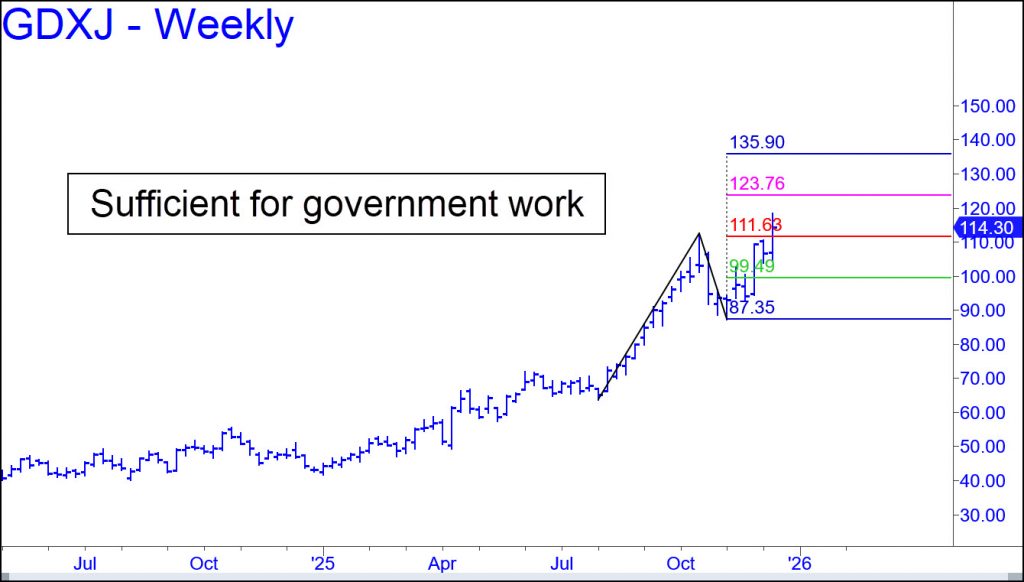THE MORNING LINE
Grand Supercycle Will End with Trump
The widespread notion that a U.S. president can significantly influence the economy is mistaken. In observable fact, the broad cycles that bring us good times and bad, booms and busts, are vastly larger and more powerful than the presidency, too overwhelming to even affect, let alone command. Even the radical policies of Roosevelt’s New Deal were insufficient to end a depression that had taken more than a generation to gather force. America’s eventual emergence from those very hard times happened gradually during the administrations of Truman, Eisenhower and Kennedy. Moreover, the post-war rebuilding process that made Europe and Japan America’s best customers arguably would have happened cyclically without a Marshall Plan, and the U.S. financial system would have receded naturally from the fiscal excesses of a war that itself was an uncontrollable cyclical event.
In this view, Kennedy, Clinton, Obama and Biden were simply lucky to have been elected with the economy and the stock market at cyclical lows. For in no way did they cause the upswings that shone on their terms in office, nor the felicitous shifts in the mood of consumers. The bullish cycle had to have been particularly strong to survive the misbegotten policies of Obama, the first president to revile American exceptionalism, if not America itself.
Surfing the Big Wave
Which brings us to Trump, the president who has come closest to affecting the economy both inside and outside the U.S. Trump inherited a fiscal blowout impelled by the covid hoax, but he has since turned it into a credit and fiscal bonfire that can only end in ashes. Trump has merely extended an especially powerful upswing that he did nothing to cause. It should have ended with the senile Biden and his autopen administration, but Trump’s aggressive economic activism gave new life to booming asset values. It is no ordinary boom, but rather the spectacular finale of a Grand Supercycle that long-wave forecasters date back as far as the 1700s. It was logical and perhaps even inevitable that the coming, severe downturn should have summoned so grandiose a personality as Trump to stage a last hurrah.
His popularity and credibility have already peaked with his all-in bet to give Americans ‘affordability’. This should have been apparent to anyone who watched his relatively short, heavily stuffed speech last week. Trump trotted out charts and tables to show how the cost of eggs, gasoline, poultry and such have begun to fall. Well, whoopee doo. But even if half-price Ozempic for every American were to arrive before midterm elections, the nation will still be dealing with the deeply structural, intractable problems of unaffordable big things: housing, healthcare, insurance, college education and automobiles. Trump’s affordability promise is doomed to failure, and every American senses this. His hubris will put a fitting end to the Grand Supercycle, and it is the reason why the stock market has seemed so dead-tired lately. [For an earful on silver, AI and ‘lunatic-sector’ stocks that have begun to sputter out, click here for my latest rant at HoweStreet.]
Rick's Free Picks

$GCG26 – Feb Gold (Last:4539.80)
February Gold has a clear path to at least 4532.70 over the near term, a midpoint Hidden Pivot resistance. Price action there cannot but provide an accurate ‘read’ on trend strength, as well as a reliable idea of the speed and likelihood of a further rally to the conventional pattern’s
SIH26 – March Silver (Last:71.57)
Silver’s ballistic ascent has left it out-of-synch with gold, which looks months away from a potential bull-market top. At the rate Silver is climbing, it could hit a correspondingly important target at 70.810 by Christmas. Since we should always have an alternative target lined up, I would need to create
$BTCUSD – Bitcoin (Last:87.792)
The chart shows the entire, insufferable month that Bitcoin speculators have spent jerking off, all of it in the context of a bear market that has lopped 36% from the value of the cryptocurrency so far. The closest downside target lies at p=81,163, a midpoint Hidden Pivot support associated with

$GDXJ – Junior Gold Miner ETF (Last:117.63)
With its weak point ‘A’ low and its obviousness, the pattern shown should not be considered reliable for predicting a precise top. However, it can still serve us in several ways. For one, the easy move through p has shortened the odds of a rally to at least D=135.90. Also,
Rick's work has been featured in
Monthly
Annually
Rick’s Picks Subscription
If you are looking for trading recommendations and forecasts that are precise, detailed and easy to follow, look no further.-
‘Uncannily accurate’ daily trading forecasts
-
Real-time alerts
-
Timely commentary on the predictions of other top gurus
-
Timely links to the world’s top financial analysts and advisors
-
Detailed coverage of stocks, cryptos, bullion,
index futures and ETFs -
A 24/7 chat room where veteran traders from around the world share opportunities and actionable ideas in real time
Rick’s Picks Subscription
If you are looking for trading recommendations and forecasts that are precise, detailed and easy to follow, look no further.-
‘Uncannily accurate’ daily trading forecasts
-
Real-time alerts
-
Timely commentary on the predictions of other top gurus
-
Timely links to the world’s top financial analysts and advisors
-
Detailed coverage of stocks, cryptos, bullion,
index futures and ETFs -
A 24/7 chat room where veteran traders from around the world share opportunities and actionable ideas in real time
Mechanical Trade Course
A very simple set-up that will have you trading profitably quickly even if you have never pulled the trigger before, and even with a small account.-
Leverage violent price action for exceptional gains without stress
-
Select trading vehicles matched to your bank account and appetite for risk
-
Reap fast, easy profits by exploiting the ‘discomfort zone’ where most traders fear to go
-
Enter all trades using limit orders that avoid slippage, even in $2000 stocks
-
Learn how to read the markets so that you no longer have to rely on the judgment of others

